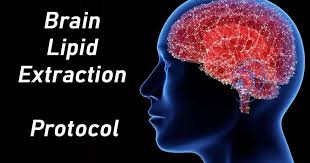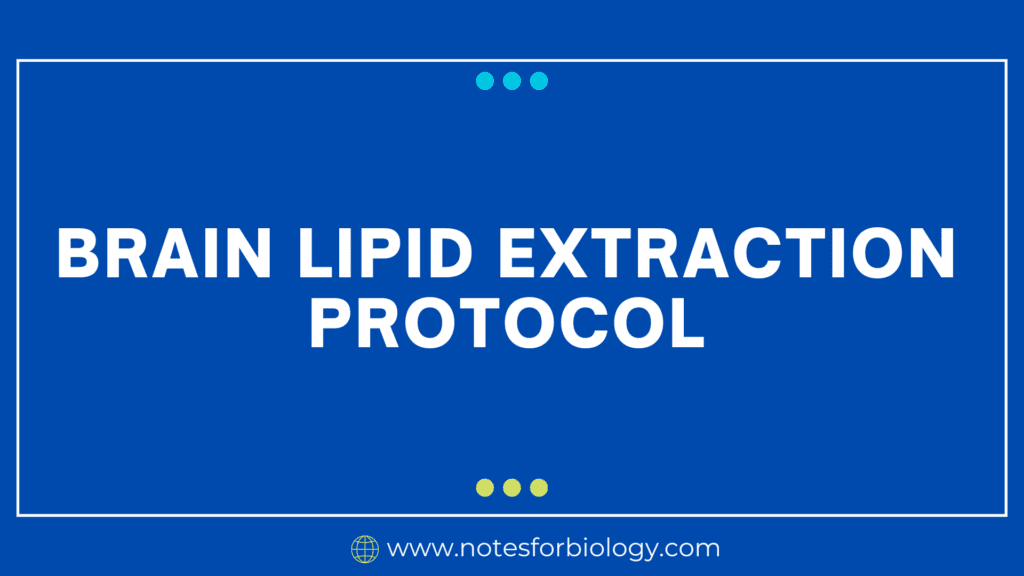Brain Lipid Extraction Protocol it means of a sequential process that separates lipids from other components of the cell. The Folch technique, which uses a chloroform-methanol solvent system, is one of the most used ones.
The Folch method is a commonly used approach for separating lipids from brain tissue, and it is utilized in the brain lipid extraction process described here. With the use of this technique, lipids and other cellular constituents may be effectively separated using a chloroform-methanol solvent mixture. The brain tissue is homogenized in a chloroform-methanol combination, phase separated using a saline solution, and then the lipid-rich chloroform phase is isolated by centrifugation. After collection, washing, and drying, the lipids are ready for further examination. Because of its excellent lipid recovery and purity, this technique may be used to a wide range of biochemical and analytical processes.

Table of Contents
Here is a detailed protocol for lipid extraction from brain tissue using this method
Materials of Brain Lipid Extraction Protocol
- Sample of brain tissue
- Methanol
- chloroform, and diluted water
- Solution of sodium chloride (NaCl) (0.9% w/v)
- Glass homogenizer or tissue grinder made by Potter-Elvehjem
- centrifuge tubes
- Centrifuge mixer with vortex
- Tips for pipettes and pipettes
- Teflon-lined glass bottles or other comparable containers
Equipment of Brain Lipid Extraction Protocol
- Centrifuge mixer with vortex
- Tissue grinder or homogenizer
- fume hood for chemicals
Protocol of Brain Lipid Extraction Protocol
1. Sample Set-Up
Accurately weigh the sample of brain tissue.
Using a scalpel or scissors, finely chop the tissue into little pieces.
2. Homogenization
Transfer the chopped tissue to a Potter-Elvehjem tissue grinder or a glass homogenizer.
To the tissue sample, add methanol and chloroform in a 2:1 (v/v) ratio. The volume should be around 20 times the tissue weight (use 20 mL of chloroform-methanol for every 1 g of tissue, for example).
3. Homogenize the Sample
Till the tissue is all broken up and a homogenous suspension is achieved, homogenize the tissue fully.
4. Phase Separation
Move the homogenate into a centrifuge tube or glass container.
Add 0.2 volumes of 0.9% NaCl solution (four milliliters of NaCl solution, for every 20 milliliters of homogenate).
To guarantee complete mixing, vortex the mixture rapidly for one to two minutes.
After letting the mixture remain at room temperature for ten minutes, divide it into two parts.
5. Centrifugation
To hasten phase separation, centrifuge the mixture at 2000 x g for 10 minutes. Lipids are found in the bottom phase (the chloroform phase), while non-lipid components are found in the upper phase (the methanol-water phase).
6. Collection of Lipid Phase
Using a pipette, carefully remove the lower chloroform phase, being careful not to damage the interface.
Move the chloroform phase into a sanitized glass vial or receptacle.
7. Washing the Lipid Extract
Use 0.2 liters of methanol-water (1:1, v/v) to wash the chloroform phase in order to get rid of any last non-lipid impurities.
Allow the mixture to split into two parts by vortexing it.
If required, centrifuge and gather the lower chloroform phase.
8. Drying the Lipid Extract
Move the chloroform phase containing lipids to a glass vial that has been previously weighed.
Chloroform should be evaporated in a fume hood using a rotary evaporator or under a nitrogen gas stream.
Weigh the vial to find the total amount of lipids once the solvent has evaporated entirely.
9. Storage
Until further examination, keep the dried lipid extract refrigerated at -20°C or -80°C.
Summary of Brain Lipid Extraction Protocol
Brain tissue is homogenized in a chloroform-methanol (2:1 v/v) combination as part of the brain lipid extraction process, which is based on the Folch method. This breaks down the tissue and releases lipids. In order to aid in phase separation, this homogenate is then combined with a 0.9% NaCl solution. Centrifugation is then used to separate the lipid-rich chloroform phase from the methanol-water phase that contains non-lipid components.
After carefully gathering the lipid-containing chloroform phase, any remaining impurities are cleaned out using a 1:1 v/v methanol-water solution. The chloroform is then evaporated under nitrogen gas or in a rotary evaporator to eliminate any remaining moisture. For upcoming biochemical examination, the dried lipid extract is then kept at -20°C or -80°C. This process guarantees a high yield and purity of lipids, making them appropriate for a range of analytical uses.
Frequently Asked Question
1. How are lipids extracted from brain tissue?
A straightforward procedure for making brain lipid extracts is explained. The tissue is homogenized using a 2:1 chloroform-methanol combination as part of the procedure. Filtration is used to eliminate insoluble materials, and water is then used to wash away any non-lipid contaminants from the filtrate.
2. What are the procedures for lipid extraction?
The gathering and drying of biomass is the first step in the lipid extraction process. Since the cell walls of microalgae are extremely stiff, homogenizers and cavitation are favored over mechanical presses. Later, the selected organic solvent is used to dissolve lipids.
3. What technique is used for lipid separation?
The Folch method, published in 1957, is the most commonly used lipid extraction technique (Folch et al., 1957).
4. Which lipid is found in brain?
Cholesterol, phospholipids like phosphatidylcholine (PC) and phosphatidylethanolamine (PE), and sphingolipids make up the majority of brain lipids (Fig. 1) (27). Interestingly, compared to other organs and biological fluids, the brain has a higher concentration of cholesterol (27, 38).
What do you mean by Brain Lipid Extraction Protocol ?
Brain Lipid Extraction Protocol it means of a sequential process that separates lipids from other components of the cell. The Folch technique, which uses a chloroform-methanol solvent system, is one of the most used ones.
Related Article

